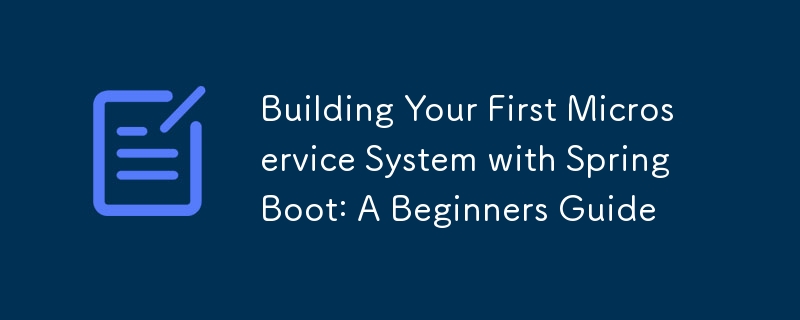

このガイドでは、Spring Boot を使用したシンプルかつ包括的なマイクロサービス システムの作成について説明します。マイクロサービスの基本、必要な環境のセットアップ、2 つのマイクロサービス (OrderService と InventoryService) の実装について説明します。さらに、Eureka と API ゲートウェイを使用してサービス検出を統合し、サービス間のルーティングを管理します。
マイクロサービスは、連携して動作する小さな独立したサービスの集合としてアプリケーションが構築されるソフトウェア アーキテクチャ スタイルです。各サービスは自己完結型であり、明確に定義された API を通じて他のサービスと通信するため、システムの柔軟性、拡張性が向上し、管理が容易になります。
私たちのシステムのアーキテクチャは、OrderService と InventoryService という 2 つのマイクロサービスで構成されます。 OrderService はリレーショナル データベース (MySQL) を使用して注文の詳細を保存し、InventoryService は NoSQL データベース (MongoDB) を使用して在庫データを管理します。また、Eureka を使用してサービス検出を実装し、リクエストのルーティングに API ゲートウェイを使用します。
始める前に、次のツールがインストールされていることを確認してください:
src/main/resources にある application.properties ファイルを開き、次の構成を追加します。
spring.datasource.url=jdbc:mysql://localhost:3306/orderservice spring.datasource.username=root spring.datasource.password=yourpassword spring.datasource.driver-class-name=com.mysql.cj.jdbc.Driver spring.jpa.hibernate.ddl-auto=update spring.jpa.show-sql=true spring.jpa.properties.hibernate.dialect=org.hibernate.dialect.MySQL8Dialect server.port=8081
src/main/java/com/ordersystem/orderservice/model/Order.java に Order エンティティ クラスを作成します。
package com.ordersystem.orderservice.model;
import lombok.AllArgsConstructor;
import lombok.Data;
import lombok.NoArgsConstructor;
import javax.persistence.*;
@Data
@AllArgsConstructor
@NoArgsConstructor
@Entity
@Table(name = "orders")
public class Order {
@Id
@GeneratedValue(strategy = GenerationType.IDENTITY)
private Long id;
private String product;
private int quantity;
private double price;
}
src/main/java/com/ordersystem/orderservice/repository/OrderRepository.java に OrderRepository インターフェースを作成します。
package com.ordersystem.orderservice.repository;
import com.ordersystem.orderservice.model.Order;
import org.springframework.data.jpa.repository.JpaRepository;
public interface OrderRepository extends JpaRepository<Order, Long> {
}
src/main/java/com/ordersystem/orderservice/service/OrderService.java に OrderService クラスを作成します。
package com.ordersystem.orderservice.service;
import com.ordersystem.orderservice.model.Order;
import com.ordersystem.orderservice.repository.OrderRepository;
import org.springframework.beans.factory.annotation.Autowired;
import org.springframework.stereotype.Service;
import java.util.List;
@Service
public class OrderService {
@Autowired
private OrderRepository orderRepository;
public List<Order> getAllOrders() {
return orderRepository.findAll();
}
public Order getOrderById(Long id) {
return orderRepository.findById(id).orElse(null);
}
public Order createOrder(Order order) {
return orderRepository.save(order);
}
public void deleteOrder(Long id) {
orderRepository.deleteById(id);
}
}
src/main/java/com/ordersystem/orderservice/controller/OrderController.java に OrderController クラスを作成します。
package com.ordersystem.orderservice.controller;
import com.ordersystem.orderservice.model.Order;
import com.ordersystem.orderservice.service.OrderService;
import org.springframework.beans.factory.annotation.Autowired;
import org.springframework.web.bind.annotation.*;
import java.util.List;
@RestController
@RequestMapping("/api/orders")
public class OrderController {
@Autowired
private OrderService orderService;
@GetMapping
public List<Order> getAllOrders() {
return orderService.getAllOrders();
}
@GetMapping("/{id}")
public Order getOrderById(@PathVariable Long id) {
return orderService.getOrderById(id);
}
@PostMapping
public Order createOrder(@RequestBody Order order) {
return orderService.createOrder(order);
}
@DeleteMapping("/{id}")
public void deleteOrder(@PathVariable Long id) {
orderService.deleteOrder(id);
}
}
src/main/resources にある application.properties ファイルを開き、次の構成を追加します。
spring.data.mongodb.uri=mongodb://localhost:27017/inventoryservice server.port=8082
src/main/java/com/ordersystem/inventoryservice/model/InventoryItem.java に InventoryItem エンティティ クラスを作成します。
package com.ordersystem.inventoryservice.model;
import lombok.AllArgsConstructor;
import lombok.Data;
import lombok.NoArgsConstructor;
import org.springframework.data.annotation.Id;
import org.springframework.data.mongodb.core.mapping.Document;
@Data
@AllArgsConstructor
@NoArgsConstructor
@Document(collection = "inventory")
public class InventoryItem {
@Id
private String id;
private String product;
private int quantity;
}
src/main/java/com/ordersystem/inventoryservice/repository/InventoryRepository.java に InventoryRepository インターフェースを作成します。
package com.ordersystem.inventoryservice.repository;
import com.ordersystem.inventoryservice.model.InventoryItem;
import org.springframework.data.mongodb.repository.MongoRepository;
public interface InventoryRepository extends MongoRepository<InventoryItem, String> {
}
Create the InventoryService class in src/main/java/com/ordersystem/inventoryservice/service/InventoryService.java:
package com.ordersystem.inventoryservice.service;
import com.ordersystem.inventoryservice.model.InventoryItem;
import com.ordersystem.inventoryservice.repository.InventoryRepository;
import org.springframework.beans.factory.annotation.Autowired;
import org.springframework.stereotype.Service;
import java.util.List;
@Service
public class InventoryService {
@Autowired
private InventoryRepository inventoryRepository;
public List<InventoryItem> getAllItems() {
return inventoryRepository.findAll();
}
public InventoryItem getItemById(String id) {
return inventoryRepository.findById(id).orElse(null);
}
public InventoryItem createItem(InventoryItem item) {
return inventoryRepository.save(item);
}
public void deleteItem(String id) {
inventoryRepository.deleteById(id);
}
}
Create the InventoryController class in src/main/java/com/ordersystem/inventoryservice/controller/InventoryController.java:
package com.ordersystem.inventoryservice.controller;
import com.ordersystem.inventoryservice.model.InventoryItem;
import com.ordersystem.inventoryservice.service.InventoryService;
import org.springframework.beans.factory.annotation.Autowired;
import org.springframework.web.bind.annotation.*;
import java.util.List;
@RestController
@RequestMapping("/api/inventory")
public class InventoryController {
@Autowired
private InventoryService inventoryService;
@GetMapping
public List<InventoryItem> getAllItems() {
return inventoryService.getAllItems();
}
@GetMapping("/{id}")
public InventoryItem getItemById(@PathVariable String id) {
return inventoryService.getItemById(id);
}
@PostMapping
public InventoryItem createItem(@RequestBody InventoryItem item) {
return inventoryService.createItem(item);
}
@DeleteMapping("/{id}")
public void deleteItem(@PathVariable String id) {
inventoryService.delete
Item(id);
}
}
Open the application.properties file in src/main/resources and add the following configuration:
server.port=8761 eureka.client.register-with-eureka=false eureka.client.fetch-registry=false
Annotate the main application class in src/main/java/com/ordersystem/eurekaserver/EurekaServerApplication.java with @EnableEurekaServer:
package com.ordersystem.eurekaserver;
import org.springframework.boot.SpringApplication;
import org.springframework.boot.autoconfigure.SpringBootApplication;
import org.springframework.cloud.netflix.eureka.server.EnableEurekaServer;
@SpringBootApplication
@EnableEurekaServer
public class EurekaServerApplication {
public static void main(String[] args) {
SpringApplication.run(EurekaServerApplication.class, args);
}
}
Add the Eureka client dependency to both OrderService and InventoryService:
<dependency>
<groupId>org.springframework.cloud</groupId>
<artifactId>spring-cloud-starter-netflix-eureka-client</artifactId>
</dependency>
Add Eureka client configuration to the application.properties files:
eureka.client.service-url.defaultZone=http://localhost:8761/eureka/ spring.application.name=order-service
eureka.client.service-url.defaultZone=http://localhost:8761/eureka/ spring.application.name=inventory-service
Open the application.yml file in src/main/resources and add the following configuration:
server:
port: 8080
spring:
application:
name: api-gateway
cloud:
gateway:
routes:
- id: order-service
uri: lb://order-service
predicates:
- Path=/api/orders/**
- id: inventory-service
uri: lb://inventory-service
predicates:
- Path=/api/inventory/**
eureka:
client:
service-url:
defaultZone: http://localhost:8761/eureka/
Annotate the main application class in src/main/java/com/ordersystem/apigateway/ApiGatewayApplication.java with @EnableDiscoveryClient:
package com.ordersystem.apigateway;
import org.springframework.boot.SpringApplication;
import org.springframework.boot.autoconfigure.SpringBootApplication;
import org.springframework.cloud.client.discovery.EnableDiscoveryClient;
@SpringBootApplication
@EnableDiscoveryClient
public class ApiGatewayApplication {
public static void main(String[] args) {
SpringApplication.run(ApiGatewayApplication.class, args);
}
}
Use Postman or any other API client to test the endpoints through the API Gateway:
In this guide, we've built a simple microservices system using Spring Boot. We created two microservices (OrderService and InventoryService), integrated service discovery with Eureka, and set up an API Gateway for routing requests. This architecture allows for scalable and maintainable microservices that can be easily extended in the future.
以上がSpring Boot を使用した最初のマイクロサービス システムの構築: 初心者ガイドの詳細内容です。詳細については、PHP 中国語 Web サイトの他の関連記事を参照してください。